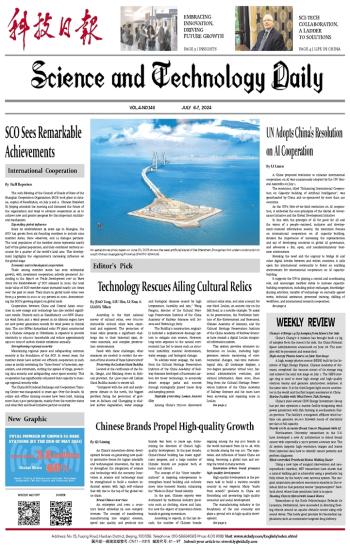
 2024 Summer Davos: Embracing Innovation, Driving Future Growth
2024 Summer Davos: Embracing Innovation, Driving Future Growth Sci-tech Collaboration, A Ladder to Solutions
Sci-tech Collaboration, A Ladder to Solutions SCO Sees Remarkable Achievements
SCO Sees Remarkable Achievements PHOTO NEWS
PHOTO NEWS UN Adopts China's Resolution on AI Cooperation
UN Adopts China's Resolution on AI Cooperation Technology Rescues Ailing Cultural Relics
Technology Rescues Ailing Cultural Relics WEEKLY REVIEW
WEEKLY REVIEW Chinese Brands Propel High-quality Growth
Chinese Brands Propel High-quality Growth New Graphic
New Graphic
Chang'e-6 Brings 1.9 Kg Samples from Moon's Far Side
China's Chang'e-6 mission has brought back 1.9 kg of samples from the moon's far side, the China National Space Administration announced on June 28. The samples will be processed and researched.
High-energy Photon Source at Joint Test Stage
A high energy photon source (HEPS) built by the Institute of High Energy Physics, Chinese Academy of Sciences, completed the vacuum circuit of its storage ring and entered the joint test stage on July 1. The HEPS storage ring is used to store high energy and high-quality electron beams and generate synchrotron radiation at the same time. It is the third largest light source accelerator in the world and the first largest accelerator in China.
Marine Facility with Wind Power, Fish Farming
China's state-owned CHN Energy Investment Group has put into operation a marine facility integrating wind power generation with fish farming in southeastern Fujian province. The facility's 4-megawatt offshore wind turbine can generate 96,000 kilowatt-hours of electricity per day at full capacity.
Nearly 100% Accurate Breast Cancer Diagnosis with AI
Northeastern University researchers in the U.S. have developed a new AI architecture to detect breast cancer with reportedly a 99.72 percent accuracy rate. The AI system inspects high-resolution images and learns from historical data how to identify cancer patterns and perform diagnoses.
Mind-controlled Prosthesis Makes Walking Easier
Using a new type of surgical intervention and neuroprosthetic interface, MIT researchers have shown that a natural walking gait is achievable using a prosthetic leg fully driven by the body's own nervous system. The surgical amputation procedure reconnects muscles in the residual limb so that patients receive "proprioceptive" feedback about where their prosthetic limb is in space.
Floating Objects Moved with Sound Waves
Researchers at the Ecole Polytechnique Federale de Lausanne, Switzerland, have succeeded in directing floating objects around an aquatic obstacle course using only sound waves. This holds great promise for biomedical applications such as noninvasive targeted drug delivery.

 Next
Next



